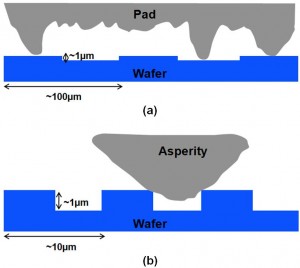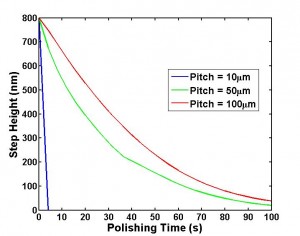Die-level CMP Model Combining Pattern Density and Feature Size Effects
- Category: Electronic Devices
- Tags: duane boning, wei fan
In our previous work on CMP modeling, we developed an original physical die-level model to understand the pattern density dependence of planarization since it is known to be the dominant effect of die-level non-uniformity [1] . However, a significant variation with layout feature size is also observed in oxide CMP [2] . A recent modeling improvement focuses on feature size effects based on empirical die-level models [3] . A physically-based die-level model including both pattern density and feature size effects is desired.
To understand the feature size effect, an extended physical die-level model is developed by considering the interactions between CMP pad asperities and step features on a chip. The extended die-level model attributes feature size dependence on pad asperity size and asperity shape. As shown in Figure 1, although both features have same pattern density, small feature planarization is faster than in large features because no down area removal occurs until a late polishing stage. Since the shape of a step feature during CMP is not ideal due to the structure corner roll off, a parabolic shape approximation can be made to utilize the Greenwood-Williamson approach including the curvature of up and down areas of each feature [3] . Then Hertzian contact theory [4] is applied to calculate pressure distribution, and Preston’s law [5] is used to estimate the die-level topography evolution during the CMP process. A full-chip simulation on an MIT standard STI CMP test layout shows that small features are planarized faster than large features (Figure 2), even though they have same pattern density.
- Figure 1: Contact between asperities and step features with 50% density on a chip: (a) large feature size. The asperities can touch both up area and down areas (b) small feature size. The asperities can only touch up area in the early stage of polishing.
- Figure 2: Feature (Pitch) size effect in CMP. Step height evolution simulated by the extended die-particle-level model for 50% density region of MIT standard test layout. Small features (10 µm pitch) are planarized very fast because only up area material removal happens.
- X. Xie, “Physical understanding and modeling of chemical mechanical planarization in dielectric materials,” Ph.D. thesis, Massachusetts Institute of Technology, Cambridge, 2007. [↩]
- R. Rzehak, “Pitch-dependence in oxide CMP,” in Proc. Eleventh International Conference on Chemical-Mechanical Polish Planarization for ULSI Multilevel Interconnection (CMP-MIC), 2006, p. 137. [↩]
- B. Vasilev, R. Rzehak, S. Bott, P. Kucher, and J. W. Bartha, “Greenwood-Williamson model combining pattern-density and pattern-size effects in CMP,” IEEE Transactions On Semiconductor Manufacturing, vol. 24, no. 2, pp. 338-347, May 2011. [↩] [↩]
- K. L. Johnson, Contact Mechanics. Cambridge: Cambridge University Press, 1985. [↩]
- F. Preston, “The theory and design of plate glass polishing machines,” Journal of the Society of Glass Technology, vol. 11, pp. 214-256, 1927. [↩]

